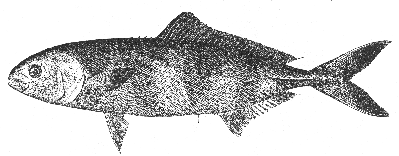Pilotfish Naucrates ductor (Linnaeus) 1758
RUDDERFISH; SHARK PILOT
[Jordan and Evermann, 1896-1900, p. 900.]

Figure 197.—Pilotfish (Naucrates ductor), about 13 inches long, New Bedford, Mass. After Goode. Drawing by H. L. Todd.
Description—
The pilotfish is one of the more slender carangids (body about one-fourth as deep as it is long), round-sided, about two-thirds as thick as it is deep, and somewhat mackerel-like in appearance though with a blunter, more rounded nose and smaller mouth, while its caudal peduncle is conspicuously keeled on either side like that of a bonito. But its long second dorsal fin separates it from all the mackerel tribe. The first dorsal fin is reduced to three or four short inconspicuous spines, which are connected by a membrane in young fish but this membrane is lost with growth. The second dorsal (26 or 27 soft rays) is weakly concave in outline and originates midway between tip of snout and base of caudal fin. The anal fin is similar to the second dorsal in form, but is only about half as long (16 or 17 rays), and is preceded by two very short spines. It resembles the rudderfish in this but the first dorsal of the latter is well developed and has 7 spines instead of only 3 or 4. The ventrals, situated far forward under the pectorals, are about as large as the latter. The caudal is large and deeply forked. The edge of [page 373] the gill cover is rounded in the adult but it bears a spine in young fry.
Color—
Bluish, cross-barred with 5 to 7 dark bands, 2 or 3 of which run up on the dorsal fin and down on the anal. The outer margins of caudal, ventral, and pectoral fins are nearly black The caudal is white-tipped.
Size—
Maximum length about 2 feet.
General range—
A tropical fish of the high seas, rarely straying as far north as outer Nova Scotia.[48]
Occurrence in the Gulf of Maine—
The only records of this species from within the Gulf are of one taken in a mackerel net in Provincetown Harbor in October 1858, the fish probably having followed a whale ship that arrived a few days previous; one caught near Seguin lsland in 1906; one off Portland in September 1921; one taken from a mackerel net at Provincetown in August 1924; three in 1929; one of them from the northern edge of Georges Bank in October, the other two from the South Channel to the southeast of Cape Cod (one in August, one in November); one off Portland, July 1931; and one picked up in a trawl on the northern slope of Georges Bank (lat. 42° 10' N., long. 66° 32' W.) October 10, 1933.[49] We need only add that this is the fish that so commonly attends sharks in tropic seas, either picking up a living from the scraps left by the latter, or feeding on the parasites with which their protectors are infested. They often follow sailing vessels, also.